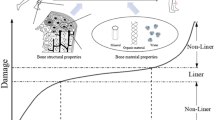Abstract
This article presents the evaluation of the high-cycle fatigue behavior in bovine compact bones under different loading frequencies. For this objective, rotating bending fatigue testing has been utilized at 10, 20 and 30 Hz of the loading frequency. Cylindrical specimens were obtained from the 12-month old bovine compact bone, considering both tibia and femur. Obtained experimental results indicated that averaged fatigue lifetimes of femur was higher than the ones of tibia. Besides, the effect of the loading frequency on the high-cycle fatigue lifetime was not significant. In addition, scanning electron microscopy images predicted brittle fractures for bones with cleavage marks. Failure mechanisms for tibia were reported as the separation of the fiber (osteon) and the matrix, micro-cracks insides the matrix, and micro-cracks of the fiber (osteon). Failure mechanisms for femur were presented as the separation of lamella layers and micro-cracks in the lamella bone.








Similar content being viewed by others
References
An YH, Draughn RA (2000) Mechanical testing of bone and the bone-implant interface. CRC Press, Boca Raton
Azadi M, Iziy M, Marbout A, Azadi M, Hajiali Mohammadi A (2016) Optimization of solution temperature and time in nickel-based superalloy of engine turbo-charger based on hardness by design of experiment. J Engine Res 43:63–70
Carpinteri A, Berto F, Fortese G, Ronchei C, Scorza D, Vantadori S (2016) Modified two-parameter fracture model for bone. Eng Fract Mech 174:44–53
Carriero A, Zimmermann EA, Shefelbine SJ, Ritchie RO (2014) A methodology for the investigation of toughness and crack propagation in mouse bone. J Mech Behav Biomed Mater 39:38–47
Carter DR, Caler W (1981) Uniaxial fatigue of human cortical bone, the influence of tissue physical characteristics. Biomechanics 14:461–470
Carter DR, Hayes WC, Schurman DJ (1976) Fatigue life of compact bone effects of microstructure and density. Biomechanics 9:211–218
Cristofolini L (2015) In vitro evidence of the structural optimization of the human skeletal bones. J Biomech 48(5):787–796
Fatihhi SJ, Rabiatul AAR, Harun MN, AbdulKadir MR, Kamarul T, Syahrom A (2016) Effect of torsional loading on compressive fatigue behavior of trabecular bone. J Mech Behav Biomech Mater 54:21–32
Hofstaetter SG, Riedl M, Glisson RR, Trieb K, Easley ME (2015) The influence of patient age and bone mineral density on osteotomy fixation stability after hallux valgus surgery. Clin Biomech 32:255–260
Kim JH, Niinomi M, Akahori T, Toda H (2007) Fatigue properties of bovine compact bones that have different microstructures. Int J Fatigue 29:1039–1050
Kong L, Zhao Y, Hu K, Li D, Zhou H, Wu Z, Liu B (2009) Selection of the implant thread pitch for optimal biomechanical properties: a three-dimensional finite element analysis. Adv Eng Softw 40:474–478
Kruzica JJ, Ritchie RO (2008) Fatigue of mineralized tissues: cortical bone and dentin. J Mech Behav Biomed Mater 1:3–17
Lafferty JF, Raju PVV (1979) The influence of stress frequency on the fatigue strength of cortical bone. J Biomech Eng 101:112–113
Libonati F, Vergani L (2014) Bone toughness and crack propagation: an experimental study. Procedia Eng 74:464–467
Libonati F, Vergani L (2016) Understanding the structure-property relationship in cortical bone to design a biomimetic composite. Compos Struct 139:188–198
Montgoery DC (2012) Design and analysis of experiments. Wiley, New York
Schaffler MB, Radin EL, Burr DB (1990) Long-term fatigue behavior of compact bone at low strain magnitude and rate. Bone 11:321–326
Swanson SAV, Freeman MAR, Day WH (1971) The fatigue properties of human cortical bone. Med Biol Eng 9:23–32
Tanner KE, Wang JS, Kjellson F, Lidgren L (2010) Comparison of two methods of fatigue testing bone cement. Acta Biomater 6:943–952
Taylor D (1998) Fatigue of bone and bones: an analysis based on stressed volume. Orthop Res Study 16:163–169
Taylor D (2000) Scaling effects in the fatigue strength of bone from different animals. Theor Biol 206:299–306
Turner CH, Wang T, Burr DB (2001) Shear strength and fatigue properties of human cortical bone determined from pure shear tests. Calcif Tissue Int 69:373–378
Ural A (2011) Cohesive modeling of bone fracture at multiple scales. Procedia Eng 10:2827–2832
Author information
Authors and Affiliations
Corresponding author
Rights and permissions
About this article
Cite this article
Azadi, M., Farzannasab, M. Evaluation of high-cycle fatigue behavior in compact bones at different loading frequencies. Meccanica 53, 3517–3526 (2018). https://doi.org/10.1007/s11012-018-0893-4
Received:
Accepted:
Published:
Issue Date:
DOI: https://doi.org/10.1007/s11012-018-0893-4




